At what point is a fish-out-of-water no longer a fish? Many films can be described as ‘fish-out-of-water’ stories, but very few take this as literally as Disney Pixar’s Luca. Our eponymous character is a sea monster, living with his family off the coast of the fictional Italian town of Portorosso and spending his days tending to his family’s herd of goatfish. Typical of the Pixar narrative, the adolescent Luca is bored with his mundane life under the sea, longing to explore the world beyond it; a world where sea monsters like him can transform into humans upon terra firma. Here, Luca meets fellow sea monster Alberto, and the two venture to Portorosso to experience life as humans. The only problem… the two need to stay dry or their true form will emerge, putting them in danger in a town where their species is feared and hated. The metamorphic nature of the boys clearly challenges boundaries of identity, the line between human and animal. This begs the question to the film’s audience; where do they stop being a ‘monster’ and when do they become ‘human’?
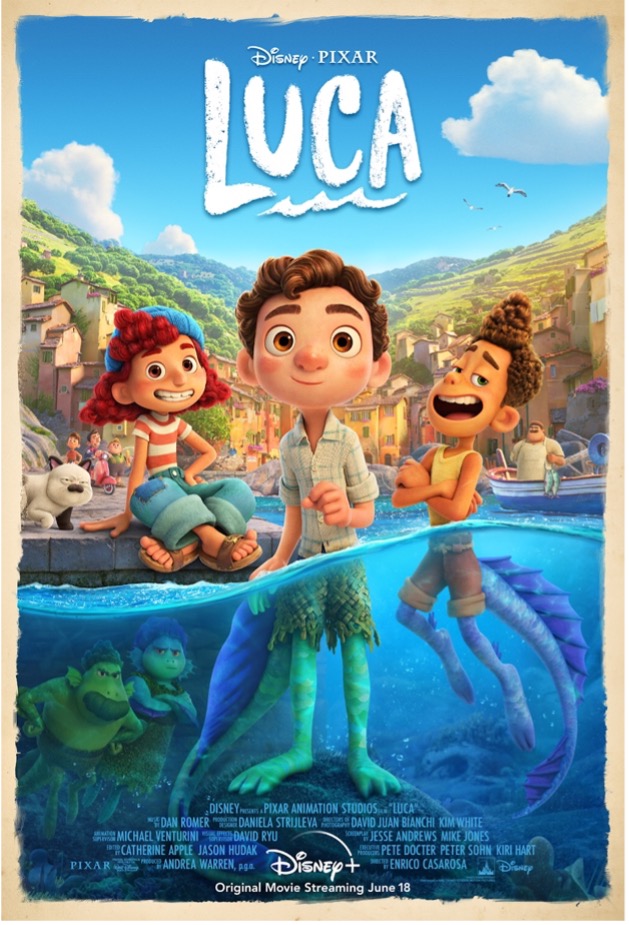
As is typical of Pixar’s filmic repertoire, Luca falls under the blanket of family film, with director Enrico Casarosa providing his own take on the challenges of adolescence. Unique to the world of animation, Pixar are known for creating ‘a world rich with political allegory, stuffed to the gills with queerness and rife with analogies between human beings and animals’[1] – it is this world that enables Pixar’s play with the metaphysics of anthropomorphism. Casarosa’s warm and whimsical aesthetic gives audiences a story that teases aspects of anthropomorphism, as Luca and Alberto navigate the uneasy transitions between monster and human, along with the perils and pitfalls of friendship, loyalty and acceptance that come hand in hand with it. This journey is made more difficult through their struggle to locate their identity between monster and human, as Casarosa describes, ‘the point of the story is the two factions, humans and sea monsters, think of the others as monsters, not themselves’[2]. Undoubtedly, the dichotomy between their two forms exemplifies this, embodying the static nature of the characters and evoking and undermining stereotypes about animality and aspects of humanity. It is here that the ‘animagic’ of Pixar’s animation is crucial, reflecting the timeless, inescapable interbeingness of all creatures, human and non-human.
The design of the animation, with its mixture of the fantastic and sublime, seeks to emulate the beauty of the Italian Riviera, and aids in blurring the boundaries of species explored within the film. When audiences are first introduced to Luca, we see him tending to his herd of goatfish, struggling to keep eyes on all at once, consequently having to chase them through the undersea community of the sea monsters. Immediately, it is made apparent that the sea monsters are far from being ‘monstrous.’ Instead, they have human-like characteristics interlaced with fish-like features that together, create a monstrous body: having human legs with fins and webbed feet and hands, they are neither definitively human nor animal. Through this animation design, Casarosa highlights how the two species are more intertwined than we might think, subtly drawing upon the discourse of species to emphasise this and enabling us to define Luca as a ‘bi-creature’. Paul Wells defines the bi-creature as ‘a creature that is neither human nor animal but, in some ways, embodies both… it is the function of the animation itself… to reveal more truths about an essential animality and humanity’[3] – something Casarosa foregrounds within the first few seconds of Luca’s introductory scene. This crossover of species allows for creative play with categories and definitions of species, further allowing the discourse of species to infiltrate the film’s storyline, an idea explored further through the goatfish.
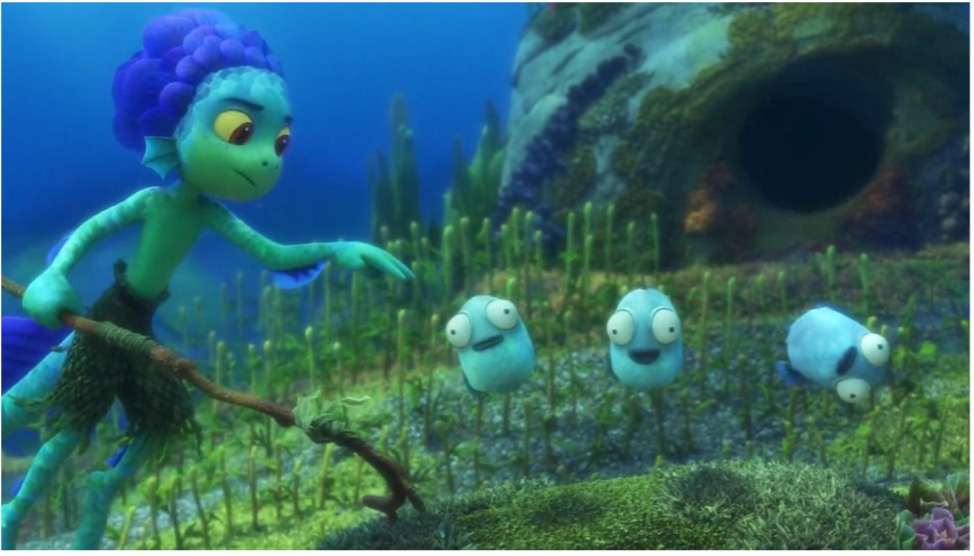
Figure 2: Luca herding the goatfish 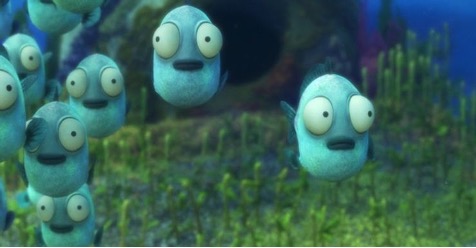
Figure 3: Giuseppe wandering away from the ‘herd’
Unlike their real-life counterparts, Casarosa’s goatfish are animated to behave in ways that are closer to that of a goat than a fish – they are herded in a flock rather than a shoal, are mischievous, and bleat. So, just as a human shepherd would tend to his goats, Luca tends to his fish to adhere to the expectations of his parents, yet this increases his yearning to break free from this mundane life. To further emphasise the role of the goatfish, it is interesting to note how members of the herd are given a sense of individuality and character, each having a different personality. What is significant here, is that Giuseppe and his character, can be read as a reflection of Luca. His constant wandering off and attempts to escape the heard alludes to Luca’s desire to explore the world beyond the flock and his underwater life, effectively addressing human-animal relations regarding how much of ourselves, as humans, do we see in the animals we have a close relationship with. The interconnectedness of species shown through the sea monsters and the goatfish is made more apparent through the music playing over the scene. The repetitive nature of the music mimics Luca’s urgency to find and return the fish to the flock, highlighting the anthropomorphism of Luca’s monster form as the portrayal of human cognition is evident in his worry about losing the fish and his determination to return them. The music develops into a playful sound, with its depth building as the non-diegetic sound merges with the intradiegetic sounds of the sea, as the sounds of swimming and the bleating of the goatfish effectively aid in establishing the underwater community of sea monsters, living, and working in a way that parallels a human community.
Audiences are further enlightened to the entanglement of species through Luca’s first transformation from monster to human, with Casarosa’s animation again, aiding in exaggerating how monsters and humans are not so far removed. When Luca walks out of the sea, upon contact with the shore, we witness his scales and fins slowly disappear, his hands and feet de-web, and his gills turn into ears and head-fins replaced with hair; at the end of this sequence, he appears unquestionably human. Using a zoom shot to focus all viewer attention on Luca’s body in this moment, Casarosa works to channel his feeling of wonder and amazement, whilst demonstrating the liminality of special being through the deployment of metamorphosis.
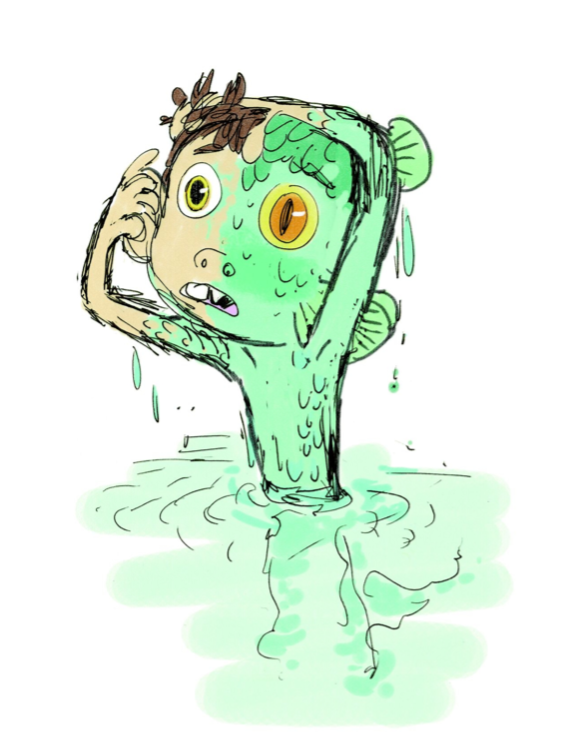
Through this scene, the boundaries of identity between monster and human are pushed to their limits, utilising animation as a genre of tactility, clearly taking delight in sensation as the sequence explores the physical surface of the world and the body. Upon completing his first transformation, Luca’s is faced with ‘phantom tail’, a clever, animalised allusion to phantom limb syndrome that reinforces the interbeingness of monsters and humans, showing how despite his bodily transformation, there are some parts of his monster body that he cannot shake entirely. Similarly, Luca very quickly attempts to stand up and walk, and immediately reverts into his ‘fish’ form, falling onto his stomach and moving like a fish-out of-water. In this moment, the animation of his character changes to reflect this, as his arms and legs become limp, his body convulses and flips around, and his eyes become wide and vacant: he is in all manners aside from his bodily state returned to an ‘animal’ state of being. This moment then bolsters the trope of the ‘bi-creature’, as the sequence highlights Luca and Alberto’s oscillation between the figures and characteristics of representational canons in the creation of fictional animals and humans within animation. In this way, Casarosa’s presentation of Luca and Alberto as ‘bi-creatures’ is extremely effective, whereby the characters become a means to investigate, define and evaluate the intersection of human and animal discourses, ultimately highlighting the ambivalence of species in animation.
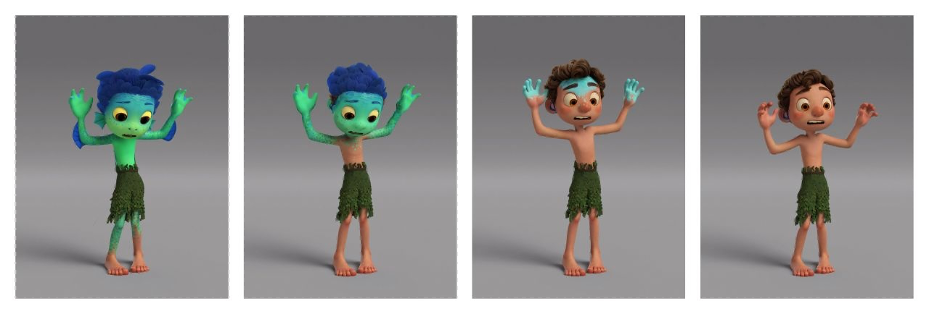
Figure 5: Animation sequence of Luca’s transformation
As Luca and Alberto find their feet as humans in Portorosso, they meet local paper girl, Giulia, who invites them home with her to dinner. Here, we are introduced to Giulia’s father Massimo, and their cat, Machiavelli. What is immediately noticeable to viewers, is how Massimo and Machiavelli resemble each other, as Casarosa implements a mode of visual wit to establish the two as human-animal counterparts.
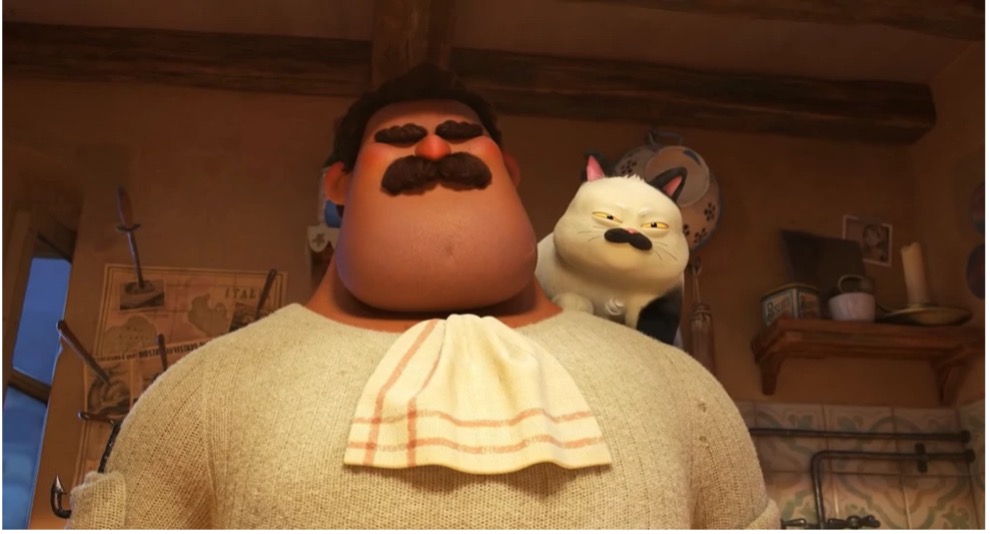
As a cat, Machiavelli can see what Massimo and Giulia cannot, witnessing Alberto’s brief, semi-transformation as a result of Luca’s reaction to Massimo’s hateful attitude towards their species. Massimo’s pessimistic, prejudiced views reflect the selfishness of species, whereby humans place themselves at the top of a special hierarchy with a kind of special superiority over non-human animals – making Alberto’s transformation more poignant as the line between what is and isn’t human is visibly apparent. In having Machiavelli be the only witness to this moment, Casarosa emphasises his role as a mute, anthropomorphic character within the animation; his inclusion serves to ‘represent the fundamental difference/distance between animal and humankind, while still allowing for the possibility that animals possess their own sentience and forms of communication’[4].
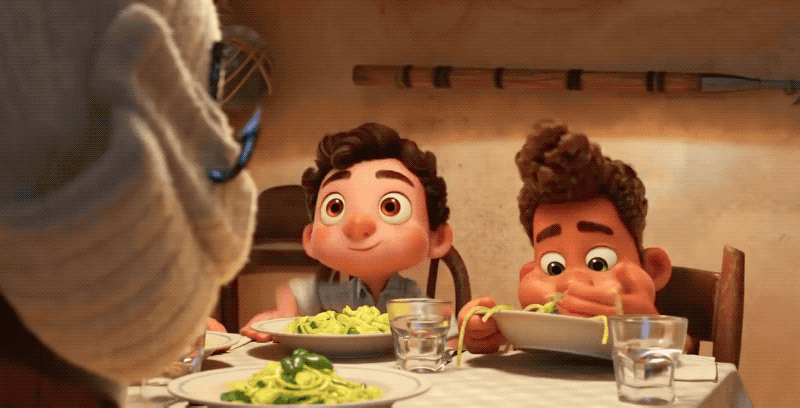
Viewers then, are almost encouraged to watch Machiavelli suspiciously, as his looking between the boys indicates a clear, responsive mind – he knows what they are and the secret they are hiding. Casarosa’s reliance on visual wit is developed after this, when Luca are Alberto are exposed to the human ‘way’ of eating, this being a stark contrast to what they are used to under the sea. This exposure to the everyday experiences of humankind can be read as a comment on the performative aspects of human nature, as the boys instinctively eat their spaghetti with their hands. Evidently, there is a contrast between their human and animal/monster nature, and this moment demonstrates how despite their human appearance, their monster instinct remains, consequently creating a hybrid identity. As the ‘camera’ shifts between Luca and Alberto’s primitive eating and Giulia’s confusion as she eats ‘normally’, the visual wit of the scene subtly challenges discourses of humanity, asking whether if we are only ‘human’ because of the learned, performative acts that remove us from our primal, animal-like tendencies, like eating with a knife and fork.
Essentially, because of their metamorphic nature, Casarosa presents Luca and Alberto as being in flux. At any time in the film, they are subject to fluid, rapid shifts between states of human and ‘monster’ (or animal), and this simply points to the larger question of what being human, or animal is, and his depictions of the boys seeks to address this. Their transformative being reveals a continuity with the animal realm, and their ability to oscilliate between their human and monster state serves as a means of demanding a renewed understanding of the natural order, and how this is exposed through the capacity of animation to create ‘bi-creatures in a curio-natural order’[5]. In creating a character that embodies all aspects of the ‘bi-creature’, Casarosa reveals the more elusive verities about essential animality and humanity, as the shared characteristics of the sea-monsters and humans links the two beings together. Clearly, the discourse of species is at play within the film, reminding audiences how humankind has anxieties regarding its place in the grand scheme of existence. Luca and Alberto signify the ambivalence of what it means to be human and/or animal.
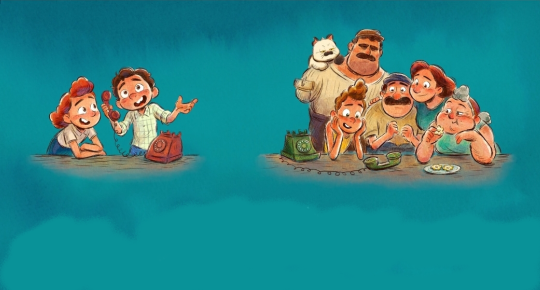
Figure 7: Luca end credits – showing the human and monster communities living harmoniously
Luca obviously defines itself as a story of what it means to be different, and what it means to be afraid of others for being different. The film maps the journey of acceptance between monster and human, as the initially prejudiced relationship of the two stems from misunderstanding, it is ground-breaking when they open their eyes and see their similarities, exposing themselves to a new appreciation of what it means to be accepted for what they truly are. For Casarosa, the intertwined nature of human and animal kind is most effectively revealed through rupture, utilising the animated mode as the optimum means of representing the animal and human in a liminal state: a state embodied by his creation of the sea-monsters. Through Luca and Alberto, audiences are invited to consider a crux of themselves that is fundamental to animal identity, and reflect on the shared animality that once accepted, facilitates the fullest understanding of what it means to be human or animal – an understanding granted to the people of Portorosso by Luca and Alberto.
[1] Halberstam, Judith, ‘Animation’, Profession, 2009.1 (2009), 44–49 < DOI: 10.1632/prof.2009.2009.1.44> p.47
[2] Bryan, Alexander, ‘Pixar’s ‘Luca’ sea-monster boys were inspired by iguanas, and there were originally three’, Yahoo Movies, 2021 https://ca.movies.yahoo.com/hunt-pixars-luca-sea-monsters-180020549.html [accessed 8 January 2022]
[3] Paul, Wells, “’You Can See What Species I Belong to, but Don’t Treat Me Lightly’: Rhetorics of Representation in Animated Animal Narratives’”, in Animal Life and the Moving Image. ed. Michael Lawrence and Laura McMahon (London: British Film Institute, 2015), pp. 95-107 (p.103)
[4] Paul, Wells, “’You Can See What Species I Belong to, but Don’t Treat Me Lightly’: Rhetorics of Representation in Animated Animal Narratives’”, in Animal Life and the Moving Image. ed. Michael Lawrence and Laura McMahon (London: British Film Institute, 2015), pp. 95-107 (p.98)
[5] Paul, Wells, “’You Can See What Species I Belong to, but Don’t Treat Me Lightly’: Rhetorics of Representation in Animated Animal Narratives’”, in Animal Life and the Moving Image. ed. Michael Lawrence and Laura McMahon (London: British Film Institute, 2015), pp. 95-107 (p.103)
Further Reading
Lawrence, Michael, McMahon, Laura, and British Film Institute, issuing body, Animal Life and the Moving Image (London; New York: Palgrave, on behalf of the British Film Institute, 2015)
Holliday, Christopher, ‘‘I’m Not a Real Boy, I’m a Puppet’: Computer-Animated Films and Anthropomorphic Subjectivity’, Animation : an Interdisciplinary Journal, 11.3 (2016), 246–62
Elizabeth Scherman, ‘Monsters Among us: Construction of the Deviant Body in Monsters, Inc. and Lilo and Stitch,’ Academia, <http://www.academia.edu/1570444/_Monsters_among_us_Construction_of_the_deviant_body_in_Monsters_Inc._and_Lilo_and_Stitch.>_[accessed 2nd January 2022]
Bibliography
Halberstam, Judith, ‘Animation’, Profession, 2009.1 (2009), 44–49 < DOI: 10.1632/prof.2009.2009.1.44>
Alexander, Bryan, ‘Pixar’s ‘Luca’ sea-monster boys were inspired by iguanas, and there were originally three’, Yahoo Movies, 2021 https://ca.movies.yahoo.com/hunt-pixars-luca-sea-monsters-180020549.html [accessed 8 January 2022]
Wells, Paul, “’You Can See What Species I Belong to, but Don’t Treat Me Lightly’: Rhetorics of Representation in Animated Animal Narratives’”, in Animal Life and the Moving Image. ed. Michael Lawrence and Laura McMahon (London: British Film Institute, 2015), pp. 95-107